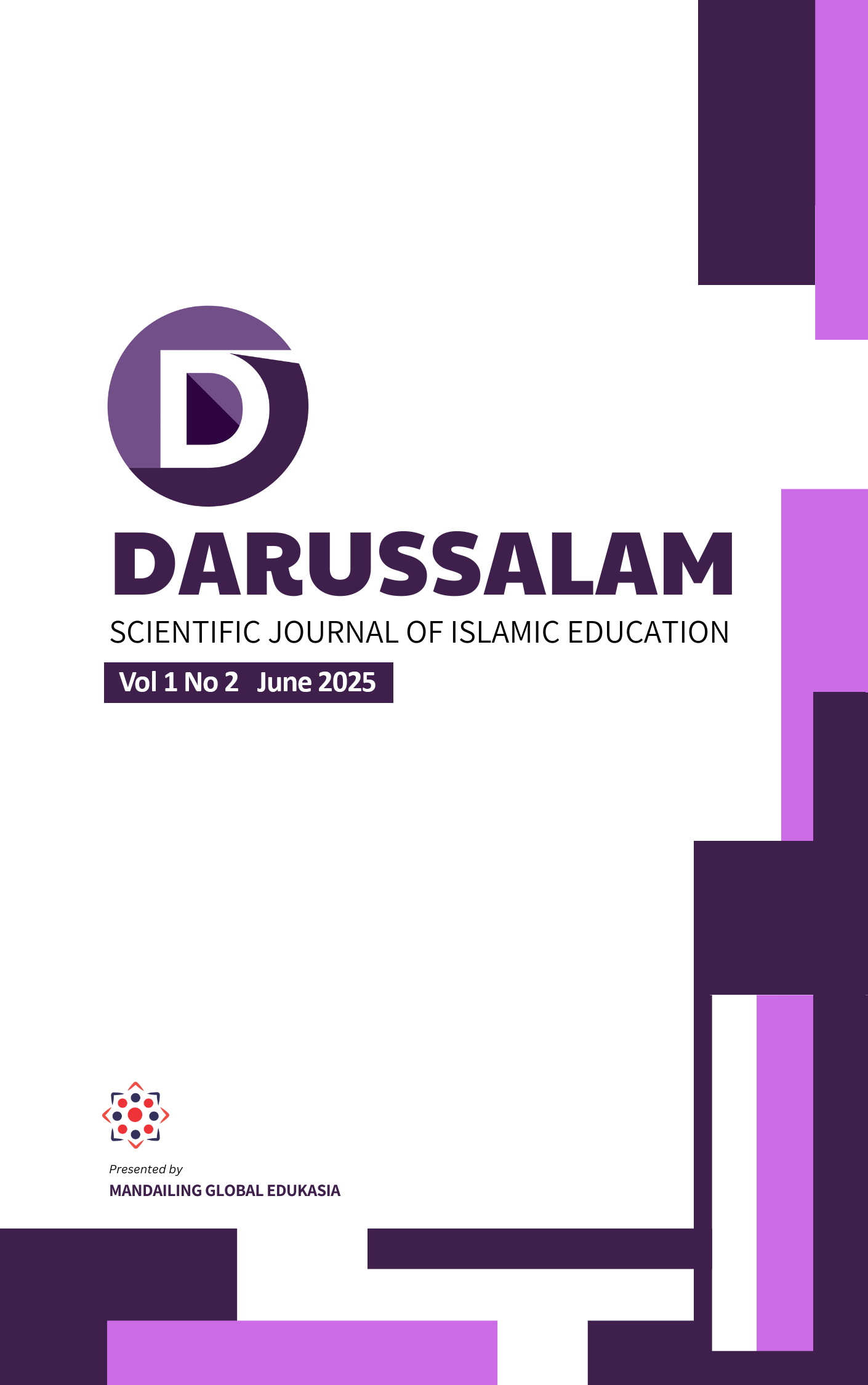Test and Non-Test Evaluation Methods in Islamic Religious Education Learning in Senior High School: A Critical Analysis Based on Literature Review to Strengthen Student-Centered Learning
DOI:
https://doi.org/10.62945/darussalam.v2i1.752Keywords:
PAI evaluation, test method, non-test method, HOTS, learner-centered learningAbstract
This study critically examines test and non-test evaluation methods in learning Islamic Religious Education (PAI) at the high school level. This research uses the literature review method with primary data in the form of 30 national and international scientific articles published between 2013-2023 from Google Scholar, ScienceDirect, DOAJ, and Moraref databases, as well as policy documents such as Merdeka Curriculum and KMA No. 183/2019. Data were collected through systematic selection using inclusion-exclusion criteria based on relevance to the topic of PAI evaluation in Indonesia. Data analysis was conducted using thematic synthesis technique to identify patterns, challenges, and recommendations in the implementation of PAI evaluation. The results showed that PAI evaluation is still dominated by conventional test methods based on memorization, while non-test methods such as observation, portfolio, and self-assessment that are more effective in assessing noble character and psychomotor skills have not been optimally implemented due to limited technical guidance and teacher training. In fact, evaluation in line with the principle of learner-centered learning demands instruments that are able to measure deep understanding, critical thinking skills, and character strengthening. However, only 30% of PAI teachers understand the preparation of Higher Order Thinking Skills (HOTS) questions, and 65% have difficulty in designing valid instruments for affective aspects. Other challenges identified include unpreparedness of school infrastructure and teachers' administrative burden. Therefore, this study recommends a hybrid evaluation model that combines HOTS-based tests with non-test methods, teacher training in instrument design, and collaboration with religious institutions to strengthen contextual assessment and support more meaningful learning for students.
References
Arfah, M. A. (2021). Evaluasi Hasil Belajar Pendidikan Agama Islam (Pai). Jurnal Literasiologi, 7(2), 211–236.
Boote, D. N., & Beile, P. (2005). Scholars before researchers: On the centrality of the dissertation literature review in research preparation. Educational Researcher, 34(6), 3–15.
Brookhart, S. M. (2010). How to assess higher-order thinking skills in your classroom. Ascd.
Brown, H. D., & Abeywickrama, P. (2019). Language assessment: Principles and classroom practices. Pearson.
Hayati, S. (2019). Persepsi Siswa Terhadap Mata Pelajaran Pendidikan Agama Islam Di SMP Negeri 1 Simpang Ulim. INSTITUT AGAMA ISLAM NEGERI LANGSA.
M. Darul Ilmi, & M. Yahya Ashari. (2024). Metode, Model dan Pendekatan Evaluasi dalam Pendidikan Islam. Jurnal Budi Pekerti Agama Islam, 2(1), 27–40. https://doi.org/10.61132/jbpai.v2i1.52
Magdalena, I., Fatmawati, F., Luthfiyah, J., & Khoiriyah, S. (2021). Pengunaan Instrumen Evaluasi Non Tes Dalam Mata Pelajaran Aqidah Akhlak Kelas Iv Di Sdi Nur Insan. EDISI, 3(2), 197–209.
Muamanah, H. (2017). Pelaksanaan Penilaian Portofolio pada Mata Pelajaran Pendidikan Agama Islam Kelas x di Sekolah Menengah Atas Negeri 5 Palembang. Doctoral Dissertation, Uin Raden Fatah Palembang.
P. (2016). Pereira, D., Flores, A., & Niklasson, L. (2016). Assessment revisited: a review of research in Assessment and Evaluation in Higher Education. 41.
Peu’uma, N. Y. (2025). Inovasi Metode Pengajaran Pai Di Era Digital. Ash-Shahabah: Jurnal Pendidikan Dan Studi Islam, 11(1), 34–40.
Popay, J., Roberts, H., Sowden, A., Petticrew, M., Arai, L., Rodgers, M., Britten, N., Roen, K., & Duffy, S. (2006). Guidance on the conduct of narrative synthesis in systematic reviews. A Product from the ESRC Methods Programme Version, 1(1), b92.
Putri, T. A., Wati, L. R., & Gusmaneli, G. (2024). Memahami Konsep Desain Pembelajaran Serta Evaluasi Penilaian dalam Pembelajaran Pendidikan Agama Islam. IHSANIKA: Jurnal Pendidikan Agama Islam, 2(4), 203–218.
Rahma, S., Erniati, E., & Hamlan, H. (2024). Problematika Guru Pendidikan Agam Islam (Pai) Dalam Menyusun Soal Berbasis Higher Order Thinking Skill (HOTS) Di SMP Negeri 2 Palu. Journal on Education, 6(4), 21019–21027. https://doi.org/10.31004/joe.v6i4.6251
Snyder, H. (2019). Literature review as a research methodology: An overview and guidelines. Journal of Business Research, 104, 333–339.
Warisno, A. (2017). Pengembangan sistem evaluasi pendidikan agama islam. 21200072, 1–186.
Widiyarto, A., & Inayati, N. L. (2023). Penerapan Evaluasi Pembelajaran Tes Dan Non-Tes Pendidikan Agama Islam di Sekolah Menengah Kejuruan. Munaddhomah: Jurnal Manajemen Pendidikan Islam, 4(2), 307–316. https://doi.org/10.31538/munaddhomah.v4i2.439
Xiao, Y., & Watson, M. (2019). Guidance on conducting a systematic literature review. Journal of Planning Education and Research, 39(1), 93–112.
Yuliani, Y. (2024). Instrumen Evaluasi Bentuk Tes Berbasis HOTS Pada Mata Pelajaran Pendidikan Agama Islam. 02(01), 47–56.
Downloads
Published
How to Cite
Issue
Section
License

This work is licensed under a Creative Commons Attribution-ShareAlike 4.0 International License.










